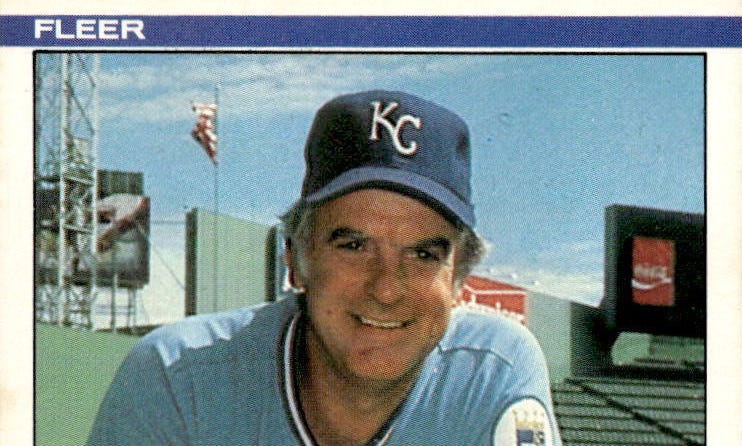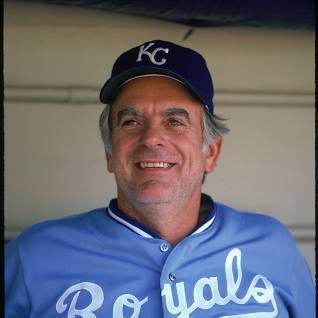Talking Transactions: 1983 Royals Add Future Hall of Famer for Stretch Run
As you probably know, the only Royals cap on a Hall of Fame plaque is found on George Brett’s. Perhaps in a few years Zack Greinke, Carlos Beltran, or maybe even Salvador Perez will join him. But the Royals have employed a few eventual Hall of Famers over the years, mostly in management positions (two of the team’s first three skippers, Joe Gordon and Bob Lemon, would be inducted for their playing exploits; general manager John Schuerholz was inducted mostly for his work in Atlanta, with his part in building the 1970s-80s Royals a strong secondary consideration).
Three players have finished up Cooperstown-worthy careers in Royal blue after building up their credentials elsewhere: Orlando Cepeda joined the team in late 1974 as a free agent but hit just .215/.282/.290 in the last 117 plate appearances of his career. A few months later, the Royals signed Harmon Killebrew, who had just been released by the Twins but wanted to keep playing. I don’t think anybody thought about the “three true outcomes” then, but Killebrew struck out 70 times, walked 54, and hit 14 home runs for the Royals in 369 plate appearances, meaning over half of his PAs ended without a ball in play. But he only hit .209 on balls in play, resulting in a .199 average overall in his final season.
The third one was a pitcher, signed by the Royals 40 years ago this week. After a decade-plus with the San Francisco Giants and six seasons split between Cleveland and Texas, Gaylord Perry was bouncing around a bit at the end of his career. He had gone from Texas to San Diego, where he became the first pitcher to win the Cy Young Award in both leagues, back to Texas, then to the Yankees, Braves, and Mariners. He had picked up his 300th win as a Mariner in early 1982 and was still mostly effective that season, going 10-12 with a 4.40 ERA, which might not sound great but was good for a 97 ERA+, meaning he was slightly below league average. For a pitcher on a bad team in a hitters’ park, not terrible.
But Perry’s 1983 was rough, with two brutal starts out of the gate. He dropped his ERA to 5.81 by the end of April and 5.32 by the end of May. While he enjoyed a solid June, with a 4.19 ERA, he was 0-4 in five starts and the Mariners were falling apart, with the team going 8-20 on the field and drama in the clubhouse, with Perry in the middle of that. Manager Rene Lachemann, who at 38 was six years younger than the pitcher, and team president Dan O’Brien had to have a meeting with Perry and tell him to stop criticizing his teammates’ efforts. A few days later, with Seattle mired in last place, the team fired Lachemann and designated Perry and shortstop Todd Cruz for assignment.
“There’s no fight in them. This team has got to get someone to hit homers, to drive the ball. They’ve got to get rid of guys who laugh when they strike out four times like it was something funny. I saw that happen here this year.”--Perry, quoted by Tracy Ringolsby, The Sporting News, July 4, 1983
As for the Royals, they were hanging around in the AL West race somehow. Kansas City reached the All-Star Break (which began on July 5 that year) with a 37-36 record, 4.5 games behind first-place Texas. The Royals had been outscored 347-315 to this point in the season but found themselves in a four-way battle for the division lead with the Rangers, California, and Chicago.
However, the Royals had started the season with a rotation that could charitably be termed “veteran” or, less kindly, “old.” Steve Renko was 38, Paul Splittorff was 36, Larry Gura was 35, and Vida Blue was “only” 33. To make matters worse, Leonard had suffered his catastrophic knee injury on May 28; the Royals knew he would be out for the season but no one could know he would also miss all of the 1984 season and much of the 1985 one. Gura, who had been 18-12 with a 4.03 ERA in 1982, was suddenly ineffective, entering the break with a 4.40 ERA; he lost all six of his starts in May. Likewise, Blue was following a solid 1982 with a bad 1983; his ERA jumped from 3.12 at the end of April to 4.73 at the end of June, and manager Dick Howser was occasionally using him in relief. Renko had already been demoted to the bullpen after 10 starts produced a 4.50 ERA. Keith Creel had joined the rotation after Leonard’s injury; his ERA for June was 8.76 in six starts. Only Splittorff and Bud Black, with a 3.72 ERA in eight starts from late May onward, were the only two dependable starters. The Royals needed help if they were to stay in striking distance in the division race.
General manager John Schuerholz sounded a bit reluctant to add Perry, but also realized he may not have a choice.
“We believe realistically, in our division, we have a chance to make the playoffs, even though we haven’t been playing consistently well. So we have to make moves to enhance that chance. At the same time, we recognize the need for long-term changes. The time has come for some changing of the guard. But as a contending club–and that’s a professional judgment, not an emotional one– we can’t just chalk off this season and throw the new blood in there all at once. Our goal and intention is to strike a balance between the two objectives.”--Schuerholz, quoted by Mike McKenzie, The Sporting News, July 18, 1983
But manager Dick Howser was all for adding the veteran; he had managed Perry before, with the Yankees in 1980.
“I think Gaylord can teach some of our younger pitchers something about how to attack a hitter. He doesn’t fool around out there.”--Howser, quoted by Mike McKenzie, The Sporting News, July 18, 1983
And so, despite Perry’s age, the Royals put in a waiver claim for him. Perry was happy to join a perennial contender, even if the club was not living up to expectations at the moment.
“It’s a winning ball club and anywhere you win it’s a lot better and a lot happier.”--Perry, quoted by UPI, July 6, 1983
“They’re just getting ready to turn this thing around, put the good pieces together and go after it. I’m going to try and win some ball games for them. That’s my main purpose. If there’s anything else I can do to help the pitchers, I’ll do it.”--Perry, quoted by the Associated Press, July 6, 1983
Of course, no one knew that the White Sox were about to go 59-26 after the break, running away with the division. Perry did go 4-4 with a 4.27 ERA, pitching 84 ⅓ innings in 14 starts. That was good for a 96 ERA+ and 0.5 bWAR. So, not too bad. Basically, Perry did pretty much what the Royals signed him to do. Unfortunately, the rest of the team had too many holes to stay in the race. The changing of the guard that Schuerholz mentioned was soon to follow, as youngsters like Bret Saberhagen, Danny Jackson, and Mark Gubicza–not quite ready to help the 1983 team–were part of a rotation overhaul that led to the 1984 division title and 1985 World Series win.
A few footnotes on Perry’s time with the Royals…to make room on the roster, Kansas City optioned catcher Russ Stephans to Omaha. Poor Stephans had only been in the majors a week and hadn’t played in a game. In fact, despite a solid 1984 season at Omaha, and making it on to at least one baseball card in a Royals uniform, Stephans would never play in a major league game, as a dislocated shoulder and then a torn rotator cuff stalled his career.
Perry’s most famous exploit as a Royal might be from a game he didn’t even appear in. After Brett’s home run was overturned by the umpires in the Pine Tar Game on July 24, Perry tried to confiscate the evidence.
“Gaylord got the bat and passed it back and tried to get it into the clubhouse. The security people went after it, but I got in there and got it. Steve Renko had it. He was the last in line. He didn’t have anyone to hand it to.”--umpire Joe Brinkman, quoted by Murray Chass, New York Times, July 25, 1983
Of course, Perry had a lot of experience concealing evidence of misdeeds on the field. He had long been accused of doctoring the baseball, or throwing spitballs, or Vaseline balls. He even titled his autobiography Me and the Spitter. Yet, in his entire career, he was only ejected one time for such misdeeds. But trying to hide Brett’s bat also got him the heave-ho.
And finally, although Perry’s time in Kansas City was short, I actually did get to go to a game he pitched. I guess it made an impression on me to remember it all these years later; I think it was probably only the second time I had been in Royals Stadium. The game turned into a blowout in the ninth, and Perry didn’t make it out of the second inning. It’s funny how you think about things as a kid (I was about to turn eight). Perry was nine years older than my dad, yet he seemed exponentially older. Like my grandparents or something. Then again, just look at him:
1983: Pitcher Gaylord Perry #26 of the Kansas City Royals in 1983. (Photo by Rich Pilling/ MLB Photos via Getty Images)


